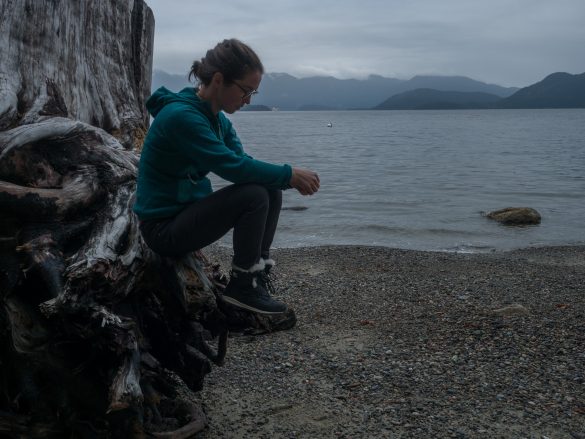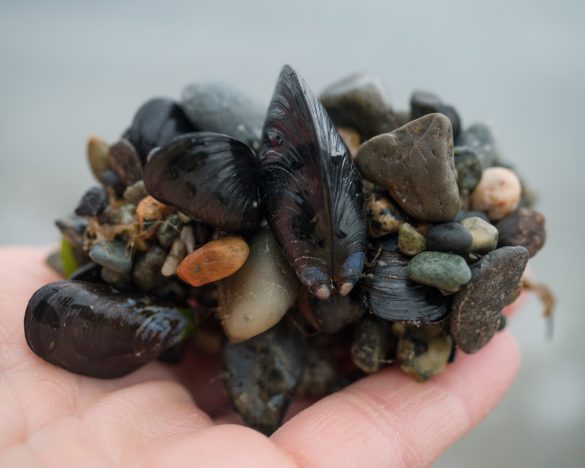“I’m so tired” I groaned. It was three o’clock in the afternoon and I couldn’t ward off an intense desire to sleep. I had slept well the night before, but my eyelids felt heavy and the couch looked so cozy. Even amidst the chaos of my three rowdy kids my body was intent on hibernating until spring. Ever since my university days, the cooler days of autumn make me feel tired, sad, hungry and lonely. These changes were especially intense when my children were babes, but over the years I’ve been slowly learning how to better manage my autumn sadness.
Autumn (or winter) sadness is called Seasonal Affective Disorder (SAD); it’s a type of depression that starts in the late fall or winter and goes away in the spring. It can come in many forms, from mild winter blues to a debilitating condition. People who experience SAD often feel sad, irritable, stressed and tired all the time; they also crave sugary and starchy foods, gain weight and avoid getting out. 1
There is a lot of debate about SAD. Researchers don’t fully understand why some people get it and others don’t. For some reason certain people, in certain parts of the world, are more sensitive to changing seasons and lack of daylight, but researchers don’t fully understand, or even agree on, why this is.
Women are more often affected by SAD than men (ratio 4:1), and SAD is also more common among younger people. 2
Are you affected by sadness in the autumn or winter month? Below I’ve shared five proven ways to help you conquer seasonal depression and enjoy autumn and winter to the fullest!
1. Seek Help
After the birth of my third child I experienced debilitating postpartum anxiety. It was a frightening experience. I wanted to reach out for help but felt alone, confused and ashamed. After several months of downward spiral, I made an appointment to see a doctor. To my surprise he was compassionate and supportive; I don’t think I was the first mommy-wreck to walk through his door. If I could go back in time, the one bit of advice I’d give myself would be “don’t wait to get help!”.
If you are experiencing symptoms of Seasonal Affective Disorder (or any form of mental illness), know that you aren’t alone. It’s important to talk about what you’re feeling. While making an appointment might feel like a monumental task, just remember: You deserve to be healthy!
In Canada, 2 to 3% of Canadians will experience SAD in their lifetime. Another 15% will experience a milder form of SAD. 1
Suggestions
- #EndTheStigma around mental illness, don’t be afraid or ashamed to talk about it with your family and friends.
- Make an appointment to talk to a medical professional (doctor, psychiatrist, psychologist etc.)
2. Go Out Into Nature
Despite the challenges of getting outside in the autumn and winter months, I’ve made it a priority for myself. Every day I challenge myself to go out with my kids and enjoy a little bit of nature, whatever the weather, even if it means a quick jaunt around the block.
Spending time in nature can increase physical activity, lower anxiety, boost creativity and improve life satisfaction. 4
The tricky thing with SAD is it often happens during seasons of the year when enjoying nature can be more difficult. The days are significantly shorter and much colder (especially here in Canada). It can be even more challenging to spend time in nature if you live in a city. Interestingly, city living actually increases the risk of for mental illness 3, including seasonal affective disorder, so making an effort to get outside is even more important for city folks.
Suggestions
- Choose an outdoor activity to enjoy throughout the winter (downhill skiing, snowboarding, cross-country skiing, snowshoeing, skating, sledding, hiking).
- Go outside with your kids and have fun together. Build a snowman, go sledding, collect icicles… the options are endless.
- Join an outdoor family challenge (Hike is Baby 30, 365 Mile Challenge, #FallOutside2017)
- Discover the practice of forest bathing (find a guide).
- Chase the sun! Make an effort to soak up the sunshine throughout the autumn and winter months. Take a quick walk around the block when the sun comes out or drive up into the mountains (above the clouds!) on the weekend to soak up the sun (preferably with skis on).
- Join a local group of fellow outdoor adventurers (check out local hiking groups, naturalist clubs and winter sport groups).
3. Try Light Therapy
My friend swears by light therapy. It’s one of the most recommended forms of treatment for people with SAD and works for a lot of people. Light therapy involves spending time in front of a bright light of 10,000 lux for 30 to 45 minutes. If sitting in front of a light for 30 minutes sounds too time consuming, then another way to use light therapy is to simulate the sun rising (dawn simulation) while you’re still sleeping. 5
There are many affordable and effective light therapy lamps on the market. I use one similar to this one first thing in the morning and I find it quite helpful.
4. Do Cognitive Behavioural Therapy
Cognitive Behavioural Therapy (CBT) is probably one of the best things that I did for my mental health. Shortly after my postpartum hell-dive I was referred to a CBT group. I was extremely anxious about joining a CBT group (ah the irony) but over the course of six weeks I learned so many great tools and strategies to help me think in a healthier way. CBT has had a very positive impact on my life.
If you’ve never heard about CBT, it’s basically a type of therapy that helps people change the way they think about something. For people with SAD this might mean challenging negative thoughts about winter and darkness. The neat thing about CBT is that studies are showing that it can be just as effective for SAD as light therapy. The added benefit is that CBT can be a really great long term solution for combating SAD.
Cognitive-behavioural therapy and light therapy are comparably effective treatment[s] [for seasonal affective disorder]. 6
Suggestions
- Ask a doctor, therapist, psychologist or psychiatrist about CBT for seasonal affective disorder (SAD).
- Join a CBT group.
- Learn about CBT by reading a book about the topic.
5. Move Your Body!
Getting regular exercise is probably the last thing I want to do in the winter months, but I force myself to do it. A few years ago I started weight lifting in my basement. It’s tough work, especially when I’d rather be taking nap, but it keeps my body and mind healthy throughout the winter months.
Regular exercise is a must for healthy living, even more so if you struggle with SAD in the winter months. Not only does it help relieve stress and anger but it can help with some of unfortunate symptoms of SAD, like weight gain and isolation.
Suggestions
- Try something new! The excitement of trying a new sport and meeting new people is a great way to combat SAD.
- Incorporate exercise into you week in a variety of ways (outdoor recreation, indoor exercise, individual sports, team sports).
- Try exercising at home if going out isn’t feasible, try this accessible routine from Strength Training 101.
- Be active with your partner, friends and most importantly kids!
Further Reading
Staying Active with Seasonal Affective Disorder (from Play Outside Guide)
References
- Canadian Mental Health Association
- Seasonal affective disorder, winter type: current insights and treatment options
- Urbanization and mental health
- Natural Environments and Mental Health
- Seasonal affective disorder, winter type: current insights and treatment options
- Randomized Trial of Cognitive-Behavioral Therapy Versus Light Therapy for Seasonal Affective Disorder
Disclaimer: This page contains Amazon Affiliates links and I may earn a small commission from your purchases made through them. By purchasing items through these links you will be supporting my work in helping families to be active outdoors together. Thank you!






